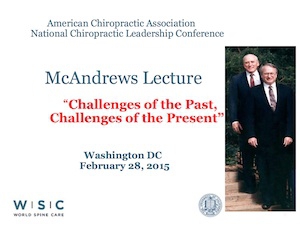
Editorial: Time to grow up
Mari-Len De
Features Leadership Profession Slides provided by Dr. Scott Haldeman
Slides provided by Dr. Scott HaldemanI have just finished watching a very enlightening YouTube video of Dr. Scott Haldeman’s McAndrews Leadership Lecture at the American Chiropractic Association’s National Chiropractic Leadership Conference, which was held last February in Washington, D.C.
In his presentation, Haldeman – a chiropractor, medical doctor, neurologist, and an international authority on spinal disorders – talked about the evolution of the chiropractic profession, its challenges and achievements from the 1960s to today. The world is very different today than it was more than five decades ago – when the chiropractic profession was largely isolated, facing organized opposition from the medical community, where philosophy dominated the discussions and significant research supporting the profession was lacking.
Fast forward to the 21st century, chiropractic is now one of the few accepted evidence-based treatments for spinal pain and chiropractors are being invited to participate in conferences and discussions related to spine and public health policy, according to Haldeman. More importantly, there is growing support for chiropractors to be identified as primary spine care clinicians.
It is really interesting to see how chiropractic has made leaps and bounds through the decades to earn its rightful place in the public health care stage. However, as Haldeman says, chiropractors still face many challenges that need to be addressed – although these are very different from the challenges of the 1960s and ’70s.
One thing that struck me was Haldeman’s observation about “poor participation” among chiropractors in national and international forums on spinal disorders, research or to learn about the latest techniques. He said this is the time for chiropractors, chiropractic organizations, educational institutions, researchers and policy experts to “understand what is happening and assume a leadership role.”
“The next five years will be the most dramatic and exciting in health care policy evolution and, in particular, spine care and the role of the chiropractic profession,” Haldeman said.
If you think about it, five years is not a long time considering the short span of time it took for chiropractors to evolve from an isolated, widely criticized profession to well-respected, highly skilled spinal care practitioners.
Haldeman puts it well: “We are not protecting chiropractors anymore. What we’re doing is protecting people with spinal problems based on our skills and knowledge, and hopefully, skills and knowledge which exceed that of anybody else in this field.”
So, five years are all you have to grow up and take your rightful place in health care. As chiropractors, you have so much to offer the world – especially with spinal disorders as the leading cause of global disability.
The combination of skills, passion and genuine concern for people’s health and well-being is what makes chiropractors great practitioners of health.
View Dr. Scott Haldeman’s McAndrews Leadership Lecture at the 2015 National Chiropractic Leadership Conference.
Print this page